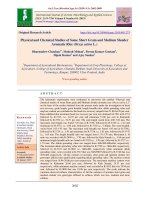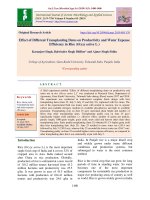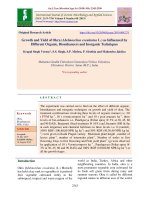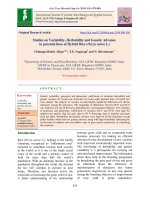Growth and yield of machine transplanted rice (Oryza sativa L.) as influenced by age and number of seedlings
Bạn đang xem bản rút gọn của tài liệu. Xem và tải ngay bản đầy đủ của tài liệu tại đây (306.53 KB, 10 trang )
Int.J.Curr.Microbiol.App.Sci (2017) 6(6): 376-385
International Journal of Current Microbiology and Applied Sciences
ISSN: 2319-7706 Volume 6 Number 6 (2017) pp. 376-385
Journal homepage:
Original Research Article
/>
Growth and Yield of Machine Transplanted Rice (Oryza sativa L.) as
Influenced by Age and Number of Seedlings
R.B. Negalur1* and A.S.Halepyati2
1
AICRP on weed management, MARS, UAS Raichur, Karnataka, India
2
College of Agriculture, UAS, Raichur, India
*Corresponding author
ABSTRACT
Keywords
Age of seedlings,
Number of
seedlings per hill,
Machine
transplanting,
Gross returns,
Net returns.
Article Info
Accepted:
04 May 2017
Available Online:
10 June 2017
Field experiment on “Effect of different age and number of seedlings on growth
and yield of machine transplanted rice (Oryza sativa L.)” was conducted at
Agricultural Research Station, Gangavathi, University of Agricultural Sciences,
Raichur and Karnataka during kharif, 2012 and 2013 in clay soil. Pooled mean of
two years indicated that, planting of twenty five days old seedlings recorded
significantly higher plant height at harvest (95.41 cm), number of green leaves per
plant at 60 DAT (87.52), number of tillers at harvest (734 m-2), leaf area plant-1 at
harvest (810 cm2), leaf area index (3.88) and grain and straw yield (5101 and 6335
kg ha-1, respectively), gross and net returns (Rs. 91,141 and 45,178 ha -1,
respectively), and benefit cost ratio of 2.01. Similarly among the number of
seedlings hill-1, planting of three to four seedling hill-1 recorded significantly
higher plant height at harvest (97.34 cm), number of green leaves per plant at 60
DAT (90.41), number of tillers at harvest (787 m-2), leaf area plant-1 at harvest
(877 cm2), leaf area index (4.18) and grain and straw yield (5330 and 6585 kg ha-1,
respectively), gross and net returns (Rs. 95,190 and 49,165 ha-1, respectively) and
benefit cost ratio 2.10.
Introduction
Proper age of seedlings for transplanting
varies with management practices, growth
period, variety and growing season. In case of
high yielding varieties, the seedlings should
be transplanted at 4-5 leaf stage (Shastry,
1977). Twenty days old seedlings were most
suitable for transplanters namely QUAT,
CRRI and Yanji (Aswini et al., 2009). There
is a necessary to optimize the age of seedlings
for minimizing root damage for proper
functioning of the transplanters (Aswini et al.,
2009).
Rice (Oryza sativa L.) is considered as the
“global grain”. It is the major staple food for
more than half of the global population. In
rice production, India ranks second as it is
grown in almost all the states of the country.
Total estimated area under rice in India is
44.40 million hectares with a production of
104.32 million tonnes. West Bengal has the
highest rice production, while Punjab has the
highest productivity of rice among the
different rice growing states of India.
376
Int.J.Curr.Microbiol.App.Sci (2017) 6(6): 376-385
Number of seedlings transplanted per hill
varies from country to country. While in
Burma, one to four seedlings are transplanted
per hill, in Sri Lanka only one seedling is
used. Usually, 5 to 7 seedlings are
transplanted in Philippines. Results in India
indicated that the number of fertile tillers
were
greater
with
3-4
seedlings
(Hedayetullaha, 1977).
Sciences,
Raichur,
Karnataka.
Field
experiment on effect of age and number of
seedlings on growth and yield of machine
transplanted rice was conducted during kharif,
2012 and 2013. The design used was laid in
strip-plot design and soil type was medium
deep black clay. The initial soil analysis of
indicated electrical conductivity (2.1), soil
reaction (8.2) estimated with the as outlined
by Jackson (1973), available N (247.2 kg ha-1)
Subbaiah and Asija (1956), available P2O5
(50.2 kg ha-1) Olsen et al., (1954) and
available K2O (357.6 kg ha-1) Jackson (1973)
at top surface 0–20 cm soil depth.
Transplanting is done manually, which is
tough and involves enormous drudgery and
human stress in sweltering weather. It
requires about 300-350 man hours per
hectare, which is approximately 25 per cent of
total labour requirement for paddy cultivation.
Non availability of labour has compounded
the situation and paddy transplanting has
emerged as the problem in the major rice
growing areas of this region. This results in
delay in transplanting and decrease in yield.
In spite of the huge labour requirement, plant
to plant and row to row spacing are not
achieved as the workers transplant seedlings
at far wider spacing that too randomly than
recommended and hence mechanical weeding
is also not possible. So also, the scarcity of
labour at peak demand period results an
increased cost of operation and delays the
transplanting operation. Hence, transplanting
of paddy seedling with a suitable mechanical
transplanter seems to be most appropriate and
promising avenue, as it minimizes drudgery
and saves much of the labour requirement
(Vasudevan et al., 2014).
The experiment consisted three different age
of seedlings viz., A1: twenty days old
seedlings, A2: twenty five days old seedlings
and A3: thirty days old seedlings and three
different number of seedlings per hill planted
by transplanter viz., N1: 3-4 seedlings per
hill, N2: 5-6 seedlings per hill and N3:7-8
seedlings per hill. The land preparation
consisted of passing of cultivator twice
followed by puddling with disc puddler twice
and finally levelled with spike tooth harrow
and three different aged seedlings raised were
transplanted on the same day.
As a pre emergent herbicide butachlor 50 EC
at the rate of 2.5 liter ha-1 was sand mixed and
broadcasted over the field uniformly having
thin film of water and two hand weedings
taken up at 20 and 40 days after transplanting.
Upto 10 days from the planting 2.5 cm depth
of standing water was maintained and was
increased to 5 cm until 10 days before the
harvest of the crop. A fertilizer dose of
(150:75:75 and 20 kg N: P2O5: K2O and
ZnSO4/ha) was applied using Urea, Diammonium phosphate (DAP), Muriate of
potash (MOP) and zinc sulphate, other plant
protection measures were taken as and when
required. At physiological maturity, the crop
was harvested, dried, threshed and cleaned
manually in both the years and dry weights of
Materials and Methods
Under Northern dry zone of Karnataka,
between 15o 15' 40" North latitude and 76o
31' 40" East longitude Agricultural Research
Station, Gangavathi is situated at an altitude
of 419 m above mean sea level where rice is
the predominant irrigated crop under
Tungabhadra command area which falls under
the jurisdiction of University of Agricultural
377
Int.J.Curr.Microbiol.App.Sci (2017) 6(6): 376-385
both grain and straw were recorded upon sun
drying for a week. Different variable costs of
items like seeds, fertilizers, irrigation, plant
protection chemicals, hiring charges of
transplanter, fuel cost and labour charges
prevailed in market during 2012 and 2013
were considered for calculating cost of
cultivation.
Number of seedling per hill
Planting of different number of seedlings per
hill produced significant influence on rice
growth parameters. Planting of 3-4 seedlings
per hill recorded significantly higher plant
height (8.99 %), number of green leaves per
plant (10.91 %), number of tillers (27.55 %)
(Table 1), leaf area (47.15 %), leaf are index
(47.18 %) and total dry matter production at
harvest (24.71 %) (Tables 1 and 2) over
planting of 7-8 seedlings per hill. Planting of
5-6 seedlings per hill was the next best
treatment. These findings can be corroborated
with the reports of Maiti and Bhattacharya
(2011) and Rasool et al., (2013) who reported
that planting of fewer numbers of seedlings
hill-1 enabled the plant to produce healthy
leaves and tillers which had undergone
normal physiological growth and field
duration, resulting in more healthy leaf area
and panicles with more filled spikelets.
Whereas, transplanting of 4 to 5 seedlings
hill-1 resulted in production of weak panicles
with less filled spikelets. Optimum plant
density for higher DMP and grain yield would
be 5 seedlings hill-1 which produced higher
DM with highest partitioning towards panicle
followed by stem and leaf (Vijayalaxmi et al.,
2016).
Results and Discussion
Growth parameters
Age of seedlings
Significant response was noticed by rice crop
due to planting of different aged seedlings.
Pooled data indicated that significantly higher
plant height (4.51 %), number of green leaves
per plant (3.34 %), number of tillers (10.70
%), leaf area (17.05 %), leaf area index (16.97
%) and total dry matter production at harvest
(8.71) were observed by planting of twenty
five days old seedlings (Tables 1 and 2) over
planting of twenty days old seedlings, but was
found to be on par with planting of thirty days
old seedlings.
The increased height of plants might be
attributed to early establishment of twenty
five days old plants and subsequently more
absorption of nutrients from the soil as
compared to other two ages of seedlings.
These results are similar with the findings of
Faruk et al., (2009).
Yield
Age of seedlings
Age of seedlings had significant influence on
yield and significantly higher grain yield
(6.20 %) and straw yield (5.65 %) was also
noticed by planting of twenty five days old
seedlings over planting of twenty days old
seedlings (4803 kg ha-1) and straw yield (5996
kg ha-1) (Table 3). This treatment was
followed by planting of thirty days old
seedlings. Kim et al., (1999) reported that
young seedlings had lower effective tiller
production rate when compared with more
Singh and Husain (1983) also reported
increased rice growth parameters with
planting of 25-30 days old seedlings and
mentioned that younger seedlings had lower
effective tiller rate and prone to mechanical
damage when compared with higher aged
seedlings. Vijayalaxmi et al., (2016) reported
25 days old seedlings as the optimum age as
for higher DMP with highest partitioning
towards panicle followed by stem and leaf.
378
Int.J.Curr.Microbiol.App.Sci (2017) 6(6): 376-385
aged seedlings. Maximum non-bearing tillers
were recorded from two weeks old seedlings
and the lowest one was in four weeks old
seedling and mentioned that number of
unbearing tillers hill-1 increased by decreasing
seedling age. This might be due to the
production of secondary and tertiary tillers in
the main field by low aged tillers which are
incapable for production of panicle. Increased
grain and straw yield due to planting of four
weeks old seedlings was also reported by
Bozorgi et al., (2011). Singh and Husain
(1983) also reported increased rice grain yield
with planting of 25–30 days old seedlings.
Table.1 Plant height, number of green leaves and number of tillers of machine transplanted rice
as influenced by age and number of seedlings
Treatments
2013
Poole
d
Number of green
leaves plant-1 at 60
DAT
2012 2013 Poole
d
93.13
97.18
94.76
0.73
91.29
95.41
93.24
0.65
83.00
85.44
84.44
0.41
86.37
89.59
88.37
0.41
84.69
87.52
86.41
0.50
2.87
2.56
1.59
1.62
99.00
95.02
91.04
1.05
97.34
93.29
89.31
1.21
88.44
84.56
79.89
1.26
4.12
4.75
98.20
95.13
90.00
93.33
91.33
84.67
89.40
88.67
1.39
97.00
101.8
7
98.13
93.73
96.67
94.67
88.67
93.00
91.47
0.99
NS
NS
Plant height (cm)
at harvest
2012
Main treatments (A)
A1
89.44
A2
93.64
A3
91.71
0.64
S.Em.±
C.D.
2.51
(P=0.05)
Sub treatments (N)
N1
95.67
N2
91.56
N3
87.58
0.99
S.Em.±
C.D.
3.90
(P=0.05)
Interaction (A x N)
A1N1
93.67
A1N2
A1N3
A2N1
A2N2
A2N3
A3N1
A3N2
A3 N3
S.Em.±
C.D.
(P=0.05)
Number of tillers m-2 at
harvest
2013
Poole
d
657
732
705
9.62
668
736
717
9.22
663
734
712
9.53
1.98
37.77
36.20
37.42
92.37
88.81
83.14
1.24
90.41
86.69
81.52
1.10
782
698
614
17.97
793
708
619
19.21
787
703
617
18.61
4.96
4.85
4.32
70.57
75.42
73.09
95.34
100.0
4
96.63
91.87
95.00
93.00
86.67
91.20
90.07
1.24
86.33
90.37
88.35
752
763
758
89.67
89.33
84.00
85.67
84.00
78.67
81.00
80.00
0.47
93.70
93.03
88.03
90.03
88.37
80.70
85.03
83.70
0.69
91.69
91.18
86.02
87.85
86.19
79.69
83.02
81.85
1.34
811
782
672
731
691
547
653
643
25.53
818
800
682
732
712
560
658
640
21.15
815
791
677
732
702
554
656
642
26.28
NS
NS
NS
NS
NS
NS
NS
379
2012
Int.J.Curr.Microbiol.App.Sci (2017) 6(6): 376-385
Table.2 Leaf area per plant, leaf area index and total dry matter production of machine
Transplanted rice as influenced by age and number of seedlings
Treatments
Leaf area plant-1 (cm2)
at harvest
2012
Leaf area index at
harvest
TDMP at harvest
(g plant-1)
2013
Poole
d
2012
2013
Poole
d
2012
2013
Poole
d
Main treatments (A)
A1
680
703
692
3.24
3.35
3.30
70.65
76.71
73.68
A2
805
814
810
3.83
3.88
3.86
76.93
83.27
80.10
A3
745
760
753
3.55
3.62
3.59
73.86
79.19
76.53
S.Em.±
17.40
15.80
17.69
0.08
0.08
0.08
0.84
0.85
0.87
62.04
67.47
0.32
0.30
0.33
3.29
3.34
3.43
C.D.
68.34
(P=0.05)
Sub treatments (N)
N1
873
880
877
4.16
4.19
4.18
82.02
89.08
85.55
N2
768
795
782
3.66
3.79
3.73
73.11
79.20
76.16
N3
589
603
596
2.80
2.87
2.84
66.31
70.89
68.60
S.Em.±
25.69
25.89
26.32
0.12
0.12
0.13
1.54
1.71
1.77
101.64
103.33
0.48
0.49
0.49
6.06
6.70
6.96
100.8
C.D.
8
(P=0.05)
Interaction (A x N)
A1N1
839
852
846
4.00
4.05
4.03
78.10
85.27
81.69
A1N2
907
920
914
4.32
4.38
4.35
85.87
93.78
89.83
A1N3
873
866
870
4.15
4.13
4.14
82.09
88.20
85.15
A2N1
734
774
754
3.50
3.69
3.60
70.40
76.22
73.31
A2N2
810
824
818
3.86
3.93
3.90
75.23
82.62
78.93
A2N3
761
786
774
3.62
3.74
3.68
73.69
78.77
76.23
A3N1
468
483
476
2.23
2.30
2.27
63.44
68.65
66.05
A3N2
698
698
698
3.32
3.32
3.32
69.69
73.42
71.56
A3 N3
601
628
615
2.86
2.99
2.93
65.79
70.60
68.20
S.Em.±
33.61
35.23
29.07
0.16
0.17
0.14
2.33
1.41
1.74
C.D.
(P=0.05)
NS
NS
NS
NS
NS
NS
NS
NS
NS
380
Int.J.Curr.Microbiol.App.Sci (2017) 6(6): 376-385
Table.3 Grain yield, straw yield and harvest index of machine transplanted rice as influenced by
age and number of seedlings
Grain yield (kg/ha)
Treatments
Poole
2012 2013
d
Main treatments (A)
Straw yield (kg/ha)
2012 2013 Poole
d
Harvest index
2012
Poole
2013
d
A1
4753
4853
4803
5930
6061
5996
0.45
0.45
0.45
A2
5080
5122
5101
6245
6425
6335
0.45
0.44
0.45
A3
4841
4936
4889
6049
6195
6122
0.44
0.45
0.45
S.Em.±
61
52
57
60
66
63
0.00
0.00
0.00
202
226
234
261
247
NS
NS
NS
C.D.
241
(P=0.05)
Sub treatments (N)
N1
5295
5365
5330
6515
6655
6585
0.45
0.45
0.45
N2
4834
4903
4869
6048
6208
6128
0.44
0.44
0.44
N3
4546
4643
4595
5661
5818
5740
0.45
0.45
0.45
S.Em.±
67
67
67
86
85
85
0.00
0.00
0.00
262
263
337
334
332
NS
NS
NS
C.D.
263
(P=0.05)
Interaction (A x N)
A1N1
5067
5166
5117
6368
6513
6441
0.44
0.44
0.44
A1N2
5597
5635
5616
6692
6853
6773
0.46
0.45
0.46
A1N3
5220
5295
5258
6485
6599
6542
0.45
0.45
0.45
A2N1
4715
4819
4767
5953
6023
5988
0.44
0.45
0.45
A2N2
4972
4970
4971
6138
6390
6264
0.45
0.44
0.45
A2N3
4816
4920
4868
6052
6210
6131
0.44
0.44
0.44
A3N1
4478
4574
4526
5468
5647
5558
0.45
0.45
0.45
A3N2
4671
4762
4717
5904
6032
5968
0.44
0.44
0.44
A3 N3
4488
4594
4541
5610
5775
5693
0.44
0.45
0.45
S.Em.±
106
103
100
188
116
142
0.01
0.01
0.01
C.D.
(P=0.05)
NS
NS
NS
NS
NS
NS
NS
NS
NS
381
Int.J.Curr.Microbiol.App.Sci (2017) 6(6): 376-385
Table.4 Gross returns, net returns and benefit cost ratio of machine transplanted rice as
influenced by age and number of seedlings
Gross returns (` ha-1)
2012
2013 Pooled
Main treatments (A)
Treatments
Net returns (` ha-1)
2012 2013 Pooled 2012
B:C
2013 Pooled
A1
89116
82499
85808
47331 33283 40307
2.13
1.68
1.91
A2
95187
87094
91141
52921 37435 45178
2.26
1.76
2.01
A3
90773
83939
87356
48537 34205 41371
2.15
1.69
1.92
S.Em.±
702
702
702
716
716
716
0.02
0.01
0.01
2756
2756
2812
2812
2812
0.09
0.04
0.04
C.D.
2756
(P=0.05)
Sub treatments (N)
N1
99211
91168
95190
56891 41439 49165
2.35
1.84
2.10
N2
90645
83415
87030
48580 33907 41244
2.16
1.69
1.93
N3
85220
78950
82085
43317 29576 36447
2.03
1.60
1.82
S.Em.±
946
946
946
977
977
977
0.03
0.03
0.02
3715
3715
3835
3835
3835
0.12
0.012
0.06
C.D.
3715
(P=0.05)
Interaction (A x N)
A1N1
95021
87867
91444
53059 38489 45774
2.26
1.78
2.02
A1N2
104761
95637
100199
62212 45743 53977
2.47
1.92
2.20
A1N3
97851
89999
93925
55403 40084 47744
2.30
1.81
2.06
A2N1
88442
81928
85185
46677 32729 39703
2.12
1.67
1.90
A2N2
93179
84627
88903
50971 35031 43001
2.21
1.71
1.96
A2N3
90313
83688
87000
48092 33962 41026
2.14
1.69
1.92
A3N1
83885
77702
80793
42256 28629 35442
2.01
1.58
1.80
A3N2
87620
81018
84319
45580 31530 38555
2.09
1.64
1.87
A3 N3
84156
78130
81143
42115 28570 35342
2.00
1.58
1.79
S.Em.±
1599
1599
1599
1774
1774
1774
0.06
0.08
0.05
C.D.
(P=0.05)
NS
NS
NS
NS
NS
NS
NS
NS
NS
382
Int.J.Curr.Microbiol.App.Sci (2017) 6(6): 376-385
Fig.1 Grain and Straw yield of machine transplanted rice as influenced by
Age and number of seedlings
Fig.2 Economics of machine transplanted rice as influenced by age and number of seedlings
383
Int.J.Curr.Microbiol.App.Sci (2017) 6(6): 376-385
Number of seedling per hill
Number of seedling per hill
Planting of different number of seedlings per
hill noticed significant influence on yield and
yield parameters. Planting of 3-4 seedlings
per hill produced significantly higher grain
yield (16.00 %) and straw (14.72 %) as
compared to planting of 7-8 seedlings per hill
(4595 kg ha-1) and straw yield (5740 kg ha-1)
(Table 3). However, it was followed by
planting of 5-6 seedlings per hill (4868 kg ha-1)
and straw yield (6128 kg ha-1). This may be
due to healthy and efficient individual plant
growth at lesser seedling density. The higher
yield with low seedling density might be due
to higher percentage of productive total tillers
and more interception of light. Also, grain
filling which is the process of remobilization
from stored reserves, particularly from stem,
leaves, and from current photosynthesis. So, it
may be inferred that the effectiveness of grain
filling is decided by the conditions of
particular tiller. Hence, planting of fewer
seedlings resulted in higher grain yield
(Rasool et al., 2013). Such increase in yield
contributing parameters with fewer number of
seedlings per hill were also reported by
Bozorgi et al., (2011) and Maiti and
Bhattacharya (2011).
Planting of 3-4 seedlings per hill recorded
significantly higher gross returns (Rs.
95,190), net returns (Rs. 49,165) and B: C
(2.10) as compared planting of 7-8 seedlings
per hill gross returns (Rs. 82,085), net returns
(Rs. 36,447) and B: C (1.82) (Table 4) and
this may be attributed to the higher grain and
straw yield obtained in this particular
treatment compared to other planting
geometry under study.
From the investigation it may be concluded
that, planting of twenty five days old
seedlings was found to be the best seedling
age over 20 and 30 days for transplanting by
self-propelled
mechanical
transplanter.
Planting of 3-4 seedlings per hill was
optimum for transplanting with self-propelled
mechanical transplanter when compared to 56 and 7-8 seedlings per hill.
References
Anonymous, 2011, Ministry of Agriculture,
Govt.
of
India.
http://
www.indiastat.com.
Aswini GK, Swain S and Debaraj B 2009.
Effect of seedling age on performance
of rice transplanter. Agricultural
Mechanization in Asia, Africa and Latin
America, 40(3): 41-46.
Behera BK 2000. Investigation on puddle soil
characteristics
in
relation
to
performance of self-propelled rice
transplanter. Un-published Ph.D. Thesis
G. B. Pant University of Agriculture
and Technology, Pantnagar, UP.
Bozorgi HR, Amin Faji, Khasravi Danesh,
Abdolkarim K, Ebrahim A and Freshieh
T 2011. Effect of plant density on yield
and yield component of rice. World
Applied Sci. J., 12 (11):2053-2057.
Faruk MO, Rahman MA and Hassan MA
2009. Effect of seedling age and
Economics
Age of seedlings
Planting of twenty five days old seedlings
recorded significantly higher gross returns
(Rs. 91,141), net returns (Rs. 45,178) and B:
C (2.01) as compared to planting of twenty
days old seedlings which recorded gross
returns (Rs. 85,808), net returns (Rs. 40,307)
and B: C (1.91) and it was followed by
planting of thirty days old seedlings (Table 4).
The increased net returns in case of planting
of twenty five days old seedlings was
obviously due to the higher grain and straw
yield.
384
Int.J.Curr.Microbiol.App.Sci (2017) 6(6): 376-385
number of seedling per hill on the yield
and yield contributing characters of
Dhan 33. Int. J. Sustain. Crop Prod.,
4(1):58-61.
Hedayetullaha S 1977. A study on the effect
of cultural factor in transplanted paddy
on the behaviour of some plant
characteristics influencing yield. Indian
J. Agric. Sci., 17: 39-80.
Jackson M L 1973. Soil Chemical Analysis,
(Ed.). Prentice-Hall of India, Pvt. Ltd.,
New Delhi, pp. 121-125.
Kim SS, Kim BK, Choi MG, Back MH, Choi
WY and Lee SY 1999. Effect of
seedling age on
Growth and yield of machine transplanted
rice in southern plain region. Korean J.
Crop Sci. 44(2): 122-128
Maiti PK and Bhattacharya B 2011. Effect of
seedling rate and number of seedlings
per hill on the growth and yield of
hybrid rice (Oryza sativa L.) grown in
dry (boro) season. Crop Res., 42 (1, 2 &
3): 18-22.
Naidu GJ, Rao KT, Rao AU and Reddy DS
2013. Age of seedling and planting
pattern on grain yield, protein content,
NPK uptake and post-harvest nutrient
status of rice under SRI. J. Acad. Indust.
Res., 2 (6): 334-337.
Olsen SR, Cole CL, Watanabe FS and Deaw
DA 1954. Estimation of available
phosphorous in soils by extraction with
sodium bicarbonate. United States
Departments of Agriculture circular,
p.939.
Rasool F, Habib R and Bhat MI 2013.
Agronomic evaluation of rice (Oryza
sativa L.) for plant spacing and
seedlings per hill under temperate
conditions. Pak. J. Agric. Sci. 9(2): 169172.
Shastry SVS 1977. Research note. AICRP on
rice research project. Int. Rice Com.
Newslet., 26(2): 11.
Singh G and Husain UK 1983. Modification
and testing of a manual rice
transplanter. AMA, 14(2): 25-30.
Subbaiah BV and Asija GL 1956. Rapid
procedure for determination of available
nitrogen in soils. Current. Sci., 31: 196.
Vasudevan SN, Basangouda, Mathad RC,
Doddagoudar SR and Shakuntala NM
2014. Standardization of Seedling
Characteristics for Paddy Transplanter.
Journal of Advanced Agricultural
Technologies 1(2), 141-146.
Vijayalaxmi, G., Sreenivas, G., Leela Rani, P.
and Ram Prakash, T., 2016. Influence of
Plant Densities and Age of Seedlings on
Dry Matter Partitioning and Grain Yield
Potential of Transplanted Rice (Oryza
sativa L.). International Journal of
Current Research in Biosciences and
Plant Biology, 3(4): 51-55.
How to cite this article:
Negalur, R.B. and Halepyati, A.S. 2017. Growth and Yield of Machine Transplanted Rice
(Oryza sativa L.) as Influenced by Age and Number of Seedlings.
Int.J.Curr.Microbiol.App.Sci. 6(6): 376-385. doi: />
385



![Growth and yield of Ashwagandha [Withania somnifera (L.)] as influenced by different intercropping system in Kymore plateau of Madhya Pradesh](https://media.store123doc.com/images/document/2020_01/09/medium_vsb1578562778.jpg)





